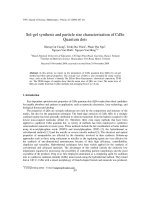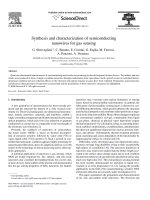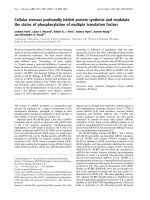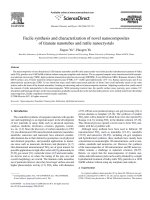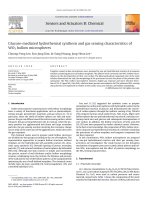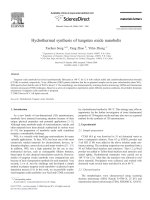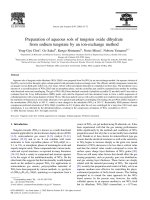- Trang chủ >>
- Khoa Học Tự Nhiên >>
- Vật lý
facile synthesis and no2 gas sensing of tungsten oxide nanorods assembled microspheres
Bạn đang xem bản rút gọn của tài liệu. Xem và tải ngay bản đầy đủ của tài liệu tại đây (1.56 MB, 6 trang )
Sensors and Actuators B 140 (2009) 514–519
Contents lists available at ScienceDirect
Sensors and Actuators B: Chemical
journal homepage: www.elsevier.com/locate/snb
Facile synthesis and NO
2
gas sensing of tungsten oxide nanorods assembled
microspheres
Zhifu Liu
a,∗
, Masashio Miyauchi
a,∗
, Toshinari Yamazaki
b
, Yanbai Shen
b
a
Nanotechnology Research Institute, National Institute of Advanced Industrial Science and Technology (AIST), Central 5, 1-1-1 Higashi, Tsukuba 305-8565, Japan
b
School of Engineering, University of Toyama, 3190 Gofuku, Toyama 930-8555, Japan
article info
Article history:
Received 14 January 2009
Received in revised form 31 March 2009
Accepted 25 April 2009
Available online 7 May 2009
Keywords:
Tungsten oxide
Microsphere
Nanorod
NO
2
Gas sensor
abstract
Tungsten oxide nanorods assembled microspheres were synthesized by a facile hydrothermal process
at 180
◦
C using ammonium metatungstate and oxalic acid as starting materials. The morphology and
structural properties were investigated using scanning electron microscopy, powder X-ray diffraction,
and transmission electron microscopy. The as-synthesized microspheres are composed of orthorhombic
WO
3
·xH
2
O nanorods with diameter less than 100 nm. These microspheres lose water gradually during
annealing and transfer to monoclinic WO
3
when annealed at 550
◦
C. The gas sensing properties of the
microspheres annealed at different temperatures were studied by exposing the gas sensors made from
microspheres to NO
2
gas. The results indicated that the crystalline phase of the microspheres has no
obvious effect on the gas sensing performance. The microspheres annealed at 350
◦
C showed fast and the
highest response to NO
2
gas due to the three-dimensional network based on the nanorods and the high
effective surface area.
© 2009 Elsevier B.V. All rights reserved.
1. Introduction
Nanostructured materials are considered as good candidates for
gas sensing applications due to their large surface area-to-volume
ratio and the size effect. Since the report of enhanced gas sensing
performance of tin oxide nano-crystallites in 1990s [1], nanomate-
rials based gas sensors attracted more and more attentions [2,3].
Nanostructures of well-established gas sensing materials like tin
oxide [4–6], zinc oxide [7], tungsten oxide [8–10], titanium oxide
[11,12], and indium oxide [13,14] have shown higher sensitivity,
faster response, lower operating temperature, and/or enhanced
capability to detect low concentration gases compared withthe thin
film counterparts.
Tungsten oxides are a class of versatile materials that offer
manifold technological applications including gas sensors [15,16],
opto-electrochromic and optical modulation devices [17,18], pho-
tocatalysis [19], hydrophilic surface design [20], etc. Gas sensors
based on tungsten oxide are sensitive to a variety of gases such as
NO
2
,O
3
,H
2
,H
2
S, andNH
3
[21]. In particular, tungsten oxide showed
superior sensitivity and selectivity in detecting NO
2
gas [22,23].On
the other hand, nanostructural tungsten oxide such as nanorods
[24], nanowires [25], nanotubes [26], nanoflakes [27], nanodisks
∗
Corresponding authors.
E-mail addresses: zhifu
(Z. Liu),
(M. Miyauchi).
[28], and nanotrees [29] have been synthesized using high tem-
perature evaporation, precipitation, hydrothermal reaction, and
electrochemical or template assisted methods. These nanostruc-
tures provide good blocks for developing high performance gas
sensors. Herein, we report the synthesisof tungsten oxide nanorods
assembled microspheres by a facile hydrothermal method. To our
knowledge, there isno report on thegas sensing of the microsphere-
like tungsten oxide nanostructures. We expect that this kind of
microsphere with nanorod substructure will benefit to the gas sens-
ing performance of their based gas sensors.
2. Experimental
2.1. Synthesis
A facile hydrothermal process was employed to synthesize the
samples. Ammonium metatungstate and oxalic acid (99.9%, Wako
Pure Chemicals Co.) were used as starting materials. In a typical
experiment, 0.53 g ammonium metatungstate and 0.72 g oxalic acid
(OA) (the mole ratio of OA/W is 4:1) were dissolved in 50 ml deion-
ized water. Clear solution was obtained after stirring for 30 min.
Then, the mixture solution was transferred into a 100 ml Teflon-
lined stainless autoclave. The autoclave was sealed and maintained
at 180
◦
C for 8 h. After the reaction completed, the resulting prod-
uct was centrifuged and washed with deionized water for three
times, and then dried at 60
◦
C overnight. Part of the product thus
treated was annealed at 350, 450, and 550
◦
C for 5 h, respectively,
0925-4005/$ – see front matter © 2009 Elsevier B.V. All rights reserved.
doi:10.1016/j.snb.2009.04.059
Z. Liu et al. / Sensors and Actuators B 140 (2009) 514–519 515
for investigating the crystal structure, morphology change, and the
gas sensing properties. For comparison, samples were also synthe-
sized at OA/W ratios of 2:1, 3:1, and 5:1 with a fixed tungsten ion
concentration by the same synthesis process.
2.2. Structural characterization
X-ray diffraction (XRD) measurements were performed on an
X-ray diffractometer (Rigaku, Ultrax 18SF) with an imaging plate
detector using Cu Ka radiation. A Hitachi S-4800 field emission
scanning electron microscope (FESEM) was used to investigate
the morphology of the samples. Transmission electron microscopy
(TEM) characterization was carried out on a Hitachi S-9000
transmission electron microscope. The effective surface area was
measured using physical adsorption/desorption of Kr on a Quan-
tachrome AUTOSORB-1-MP facility.
2.3. Gas sensing measurements
The gas sensors were made by drop-casting method. Briefly,
desired amount of the synthesized powder was dispersed in
methanol with the assist of ultrasonic. Then, the suspension was
dispensed dropwise onto the oxidized Si substrate with a pair of
interdigitated Pt electrodes. The gas sensors were ready for char-
acterization after dried and then aged at 350
◦
C for 2 h. The gas
sensing properties were measured in a tube system with a coil
resistance heater. The carrier gas (dry synthetic air) mixed with a
desired concentration of NO
2
gas was flowed at 200 ml/minthrough
the quartz tube (45 mm in diameter and 400 mm in length) kept
at a set temperature. The electrical measurement was performed
by a voltamperometric method at a constant bias of 10 V, and a
multimeter (Agilent 34970A) was used to monitor the change of
electrical resistance upon turning the target gas on and off. The
sensor response is defined as (R
a
− R
o
)/R
o
, where R
o
is the resis-
tance in air and R
a
is the maximum resistance after the NO
2
gas
was introduced.
3. Results and discussion
3.1. Structure and morphology
All the as-synthesized products are powders with white blue
color. The XRD patterns of the samples dried at 60
◦
C are shown
in Fig. 1. The results indicate that the products synthesized with
OA/W ratio of 2:1, 3:1, 4:1, and 5:1 are all crystallized and have the
same crystalline structure. The peaks of the XRD patterns can match
well with the documented diffraction pattern of orthorhombic
WO
3
·0.33H
2
O (JCPDS card no. 35-0270). Considering the possibility
of the variation of water in the structure during drying and anneal-
ing, we assign the formula of WO
3
·xH
2
O to the samples containing
water in our experiments.
Despite of the same phase composition, the morphology of the
products synthesized with different OA/W ratio is very different.
Fig. 2 presents the FESEM images of the samples synthesized with
OA/W ratio of 2:1, 3:1, 4:1, and 5:1. The sample synthesized with
OA/W ratio of 2:1 shows sphere-like aggregate with nanoplatelet
substructure. The nanoplatelet substructure can still be observed
when the ratio of OA to tungsten is increased to 3:1. However, the
products change to nanorod-like morphology when the ratio of OA
to tungsten is 4:1. These nanorods assemble to microspheres with
average diameter of around 3 m. For the sample synthesized at an
OA/W ratio of 5:1, radial nanorod aggregates are obtained. Since no
other templates or assistant agents were used in our experiments,
the formation of various microstructures at different OA/W ratios
should be ascribed to the interaction between tungsten ions and
OA. It is known that OA can stabilize the hydrolyzed tungsten oxide
Fig. 1. XRD patterns of the products synthesized with oxalic acid/tungsten mole
ratios of (a) 2:1; (b) 3:1; (c) 4:1; and (d) 5:1.
nanocrystals in aqueous solution by forming coordination com-
plex [30]. The OA ligand would af fect the growth direction of the
nanocrystals by binding to specific surface of the nanocrystals. The
WO
3
·xH
2
O nanocrystals can grow in the platelet habit in the pres-
ence of a small amount of OA. However, in the presence of large
amount of OA, for example when the OA/W ratio is 4, the crystal-
lization habit is changed by the surrounding OA ligands, leading
to the formation of rods like morphology. On the other hand, the
intermolecular force among the OA molecules may contribute to
the formation of the microsphere morphology [31]. The NH
4
+
ions
in the solution may also affect the microstructure formation [32].
More detailed work should be done to clarify the self-assembly
mechanism of the microspheres.
Fig. 3 shows a typical TEM image of the nanorods obtained
with OA/W ratio of 4:1. These nanorods have an average diameter
less than 100 nm and length in micrometer level. A correspond-
ing diffraction pattern of the nanorods is also presented in Fig. 3.
Diffraction rings can be clearly seen. The diffraction pattern, which
can be indexed to orthorhombic phase, is consistent with the XRD
results.
3.2. Effect of annealing on structural properties
Here we choose the microspheres synthesized with OA/W
ratio of 4:1 to investigate the gas sensing properties. Since gas
sensor requires a material to work continuously at high temper-
ature condition, the microspheres were annealed to stabilize the
microstructure. Fig. 4 represents the XRD patterns of the micro-
spheres annealed at 350, 450, and 550
◦
C, respectively. The sample
lost the crystalline water after annealed at 350
◦
C and transferred
to hexagonal WO
3
(JCPDS card no.33-1387). With the increase of
the annealing temperature, the diffraction peaks at 23–25
◦
and
the peaks at 26–30
◦
separate gradually, indicating that the phase
changed after annealing at higher temperature. The sample com-
pletely transferred to monoclinic WO
3
(JCPDS card no. 43-1035)
after annealed at 550
◦
C for 5 h.
The FESEM images of the samples annealed at different temper-
atures are shown in Fig. 5. For the samples annealed at 350 and
450
◦
C, the nanorods on the microsphere surface were damaged to
some extent. However, the nanorods inside the microspheres can
still be clearly seen. The nanorod substructure was totally destroyed
for the sample annealed at 550
◦
C and these nanorods changed
to nanoparticles. However, it was noticed that the microsphere
morphology still exists for the samples annealed at all conditions.
516 Z. Liu et al. / Sensors and Actuators B 140 (2009) 514–519
Fig. 2. SEM images of the products synthesized with oxalic acid/tungsten mole ratios of (a) 2:1; (b) 3:1; (c) 4:1; and (d) 5:1.
These microspheres are very helpful for forming porous sensing
layer.
The effective surface areas of the samples were evaluated by
isothermal Kr gas physical adsorption/desorption measurements
and are shown in Fig. 6. The sample dried at 60
◦
C has an effec-
tive surface area of 36 m
2
/g. The effective surface area decreases
after annealing and is 20, 13, and 6 m
2
/g for the samples annealed
at 350, 450, and 550
◦
C, respectively. Crystal growth and the par-
tial collapse of the substructure of the microspheres should be the
main reason of the decrease of effective surface area of the annealed
samples.
Fig. 3. TEM image of the WO
3
·xH
2
O nanorods synthesized with an oxalic
acid/tungsten ratio of 4:1. Inset is the corresponding diffraction pattern.
3.3. Gas sensing properties
The gas sensing properties of the annealed microspheres were
evaluated by exposing the microspheres based gas sensors to NO
2
gas. Fig. 7 shows the typical resistance change profiles of the
microsphere based gas sensors upon exposed to 1 ppm NO
2
gas
at different operating temperatures. The sensor responses quickly
to NO
2
gas at all operating temperatures. The response times (the
time for the resistance increase to 90% of the maximum) are less
than 3 min in all cases, which are much quicker than that of sput-
tered WO
3
thin film sensors measured using the same system [33].
However, we also notice that the sensor cannot recover to initial
resistance at low operating temperatures of 100 and 150
◦
C after the
Fig. 4. XRD patterns of the WO
3
·xH
2
O microspheres (a) dried at 60
◦
C and annealed
at (b) 350
◦
C; (c) 450
◦
C; and (d) 550
◦
C.
Z. Liu et al. / Sensors and Actuators B 140 (2009) 514–519 517
Fig. 5. SEM images of the WO
3
·xH
2
O microspheres annealed at (a) 350
◦
C; (b) 450
◦
C;
and (c) 550
◦
C.
NO
2
gas was turned off. The sensor can recover to initial resistance
only at temperatures above 200
◦
C.
Fig. 8 represents the responses of the sensors based on 350,
450, and 550
◦
C annealed microspheres as a function of operat-
ing temperatures. These sensors exhibit very high response at low
operating temperature. For example, the sensor based on micro-
spheres annealed at 350
◦
C showed a sensor response up to 3000
when operated at 100
◦
C. It is more than 10 times larger than the
sensor response of the thin film counterpart [33]. For all the three
kinds of materials, the sensor response decreases with the increase
of operating temperature. However, it can be noticed that the sen-
Fig. 6. Effective surface area of the WO
3
·xH
2
O microspheres (a) dried at 60
◦
C and
annealed at (b) 350
◦
C; (c) 450
◦
C; and (d) 550
◦
C.
Fig. 7. The resistance change profile of the microspheres (annealed at 350
◦
C) based
gas sensor to 1 ppm NO
2
gas at different operating temperatures.
Fig. 8. The sensor response of the microspheres based gas sensor to 1 ppm NO
2
gas
as a function of operating temperatures.
518 Z. Liu et al. / Sensors and Actuators B 140 (2009) 514–519
Fig. 9. The dynamic response of the gas sensors based on microspheres annealed at (a) 350
◦
C, (b) 450
◦
C, and (c) 550
◦
C to 1, 3, 5, 10, and 20 ppm NO
2
gas pulses. The sensor
response as a function of gas concentration is shown in (d).
sor based on microspheres annealed at 350
◦
C showed a relatively
higher response than the others.
The quick and high response of the sensors should be ascribed to
the distinctive microsphere structure with nanorod substructure. It
is accepted that, upon exposure to NO
2
gas, the NO
2
gas molecules
are directly absorbed on the active sites on tungsten oxide surface.
Charge transfer is likely to occur from WO
3
to absorbed NO
2
because
of the strong electron-withdrawing power of the NO
2
molecules,
which leads to the increase of thickness of the depletion layer [34].
The nanorod substructure in the microspheres can be fully depleted
by exposing to NO
2
gas. As a result, the barrier heights at the bound-
aries between the nanorods increase significantly, resulting in the
large increase in electrical resistance, i.e., the high sensor response.
On the other hand, for a thin film and thick film gas sensor, the
gas diffusion is one of the key factors that determines the sensor
response and response time [35]. In the present work, the sensing
layer made by microspheres is highly porous. The gas can reach the
deep layer of the microspheres based thick film quickly through
the pore network. So the effects of gas diffusion can be ignored
and the surface phenomena such as adsorption/desorption of NO
2
molecules should be the dominating factor of the sensor perfor-
mance. This is supported by the fast response of the sensors to NO
2
gas.
In order to investigate the relation between the sensor response
and gas concentration, the sensors were exposed to NO
2
gas
with concentrations of 1, 3, 5, 10, and 20 ppm. Fig. 9a–c indicates
the dynamic response of the sensors based on the microspheres
annealed at 350, 450, and 550
◦
C at an operating tempera-
tureof200
◦
C. All the three kinds of sensors exhibit good
response/recovery cycle to the NO
2
gas pulses and the sensor
responses increase with the increase of gas concentrations. Fig. 9d
shows the profiles of the sensor responses as a function of NO
2
gas concentrations. The sensor responses increase nearly linearly
with the increase of NO
2
gas concentration. It can also be noticed
that the concentration coefficient (the slop of the lines, assigned
as S
A350
,S
A450
, and S
A550
, respectively) of the sensor response
depends on the annealing temperature and follow the trend:
S
A350
>S
A450
>S
A550
. The higher effective surface area should ben-
efit to the higher response of the sensor based on 350
◦
C annealed
microspheres.
In addition, as shown previously, the phase compositions of the
annealed microspheres are different and the crystal phase changes
from hexagonal to monoclinic structure gradually when the anneal-
ing temperature increases from 350 to 550
◦
C. The gas sensing of
monoclinic tungsten oxide has been extensively studied. There are
also reports on the gas sensing of hexagonal tungsten oxide [36,37].
In our present work, there is no obvious difference in the gas sens-
ing performance among the hexagonal, monoclinic, and the mixed
phase tungsten oxide. This implies that it is possible to obtain higher
sensor response by using the materials annealed at lower tempera-
ture such as 350 and 450
◦
C under which the nanorod substructure
can be well kept.
4. Conclusions
In conclusion, the microspheres composed of WO
3
·xH
2
O
nanorod were synthesized by a facile hydrothermal process. The
microsphere morphology and the nanorod substructure can be
reserved when annealed at temperatures lower than 450
◦
C. Gas
sensing properties of the microspheres annealed at different tem-
peratures were investigated by exposing the microspheres based
gas sensors to NO
2
gas. The gas sensor based on 350
◦
C annealed
Z. Liu et al. / Sensors and Actuators B 140 (2009) 514–519 519
microspheres showed relative higher response to NO
2
gas than oth-
ers. Phase composition of the microspheres had no obvious effect
on the gas sensing performance. This kind of microspheres with
nanorod substructure provides a new block for developing high
performance gas sensors.
Acknowledgements
This work is supported by the New Energy and Industrial Tech-
nology Development Organization (NEDO) in Japan and was partly
conducted using the AIST Nano-Processing Facility, which is sup-
ported by the “Nanotechnology Support Project” of the Ministry of
Education, Culture, Sports, Science and Technology of Japan.
References
[1] J. Tamaki, C. Xu, N. Miura, N. Yamazoe, Grain size effects on gas sensitivity of
porous SnO
2
-based elements, Sens. Actuators B 3 (2) (1991) 147–155.
[2] E. Comini, Metal oxide nano-crystals for gas sensing, Anal. Chim. Acta 568 (1-2)
(2006) 28–40.
[3] A. Kolmakov, M. Moskovits, Chemical sensing and catalysis by one-dimensional
metal-oxide nanostructures, Ann. Rev. Mater. Res. 34 (2004) 151–180.
[4] A. Kolmakov, Y.X. Zhang, G.S. Cheng, M. Moskovits, Detection of CO and O
2
using
tin oxide nanowire sensors, Adv. Mater. 15 (12) (2003) 997–1000.
[5] E. Comini, G. Faglia, G. Sberveglieri, D. Calestani, L. Zanotti, M. Zha, Tin oxide
nanobelts electrical and sensing properties, Sens. Actuators B 111 (2005) 2–6.
[6] Y.B. Shen, T. Yamazaki, Z.F. Liu, D. Meng, T. Kikuta, N. Nakatani, M. Saito, M.
Mori, Microstructure and H
2
gas sensing properties undope d and Pd-doped
SnO
2
nanowires, Sens. Actuators B 135 (2009) 524–529.
[7] Q. Wan, Q.H. Li, Y.J. Chen, T.H. Wang, X.L. He, J.P. Li, C.L. Lin, Fabrication and
ethanol sensing characteristics of ZnO nanowire gas sensors, Appl. Phys. Lett.
84 (18) (2004) 3654–3656.
[8] A. Ponzoni, E. Comini, G. Sberveglieri, J. Zhou, S.Z. Deng, N.S. Xu, Y. Ding, Z.L.
Wang, Ultrasensitive and highly selective gas sensors using three-dimensional
tungsten oxide nanowire networks, Appl. Phys. Lett. 88 (20) (2006) 203101.
[9] K.M. Sawicka, A.K. Prasad, P.I. Gouma, Metal oxide nanowires for use in chemical
sensing applications, Sens. Lett. 3 (1) (2005) 31–35.
[10] C.S. Rout, A. Govindaraj, C.N.R. Rao, High-sensitivity hydrocarbon sensors based
on tungsten oxide nanowires, J. Mater. Chem. 16 (40) (2006) 3936–3941.
[11] O.K. Varghese, C.A. Grimes, Metal oxide nanoarchitectures for environmental
sensing, J. Nanosci. Nanotechnol. 3 (4) (2003) 277–293.
[12] A.S. Zuruzi, A. Kolmakov, N.C. Macdonald, M. Moskovits, Highly sensitive gas
sensor based on integrated titania nanosponge arrays, Appl. Phys. Lett. 88 (10)
(2006) 102904.
[13] C. Li, D.H. Zhang, X.L. Liu, S. Han, T. Tang, J. Han, C.W. Zhou, In
2
O
3
nanowires as
chemical sensors, Appl. Phys. Lett. 82 (10) (2003) 1613–1615.
[14] C. Li, D.J. Zhang, X.L. Liu, S. Han, T. Tang, C.W. Zhou, Doping dependent NH
3
sensing of indium oxide nanowires, Appl. Phys. Lett. 83 (9) (2003) 1845–1847.
[15] H.T. Sun, C. Cantalini, L. Lozzi, M. Passacantando, S. Santucci, M. Pelino,
Microstructural effect on NO
2
sensitivity of WO
3
thin film gas sensors. Part 1.
Thin film devices, sensors and actuators, Thin Solid Films 287 (1996) 258–265.
[16] C. Cantalini, W. Wlodarski, Y. Li, M. Passacantando, S. Santucci, E. Comini, G.
Faglia, G. Sberveglieri, Investigation on the O
3
sensitivity properties of WO
3
thin
films prepared by sol–gel, thermal evaporation and r.f. sputtering techniques,
Sens. Actuators B 64 (1-3) (2000) 182–188.
[17] T. Oi, Electrochromic materials, Ann. Rev. Mater. Sci. 16 (1986) 185–201.
[18] S.K. Deb, Opportunities and challenges in science and technology of WO
3
for
electrochromic and related applications, Solar Energy Mater. Solar Cells 92
(2008) 245–258.
[19] R. Abe, H. Takami, N. Murakami, B. Ohtani, Pristine simple oxides as visible light
driven photocatalysts: highly efficient decomposition of organic compounds
over platinum-loaded tungsten oxide, J. Am. Chem. Soc. 130 (2008) 7780–7781.
[20] M. Miyauchi, A. Nakajima, T. Watanabe, K. Hashimoto, Photocatalysis and pho-
toinduced hydrophilicity of various metal oxide thin films, Chem. Mater. 14
(2002) 2812–2816.
[21] G. Eranna, B.C. Joshi, D.P. Runthala, R.P. Gupta, Oxide materials for development
of integrated gas sensors—a comprehensive review, Crit. Rev. Solid State Mater.
Sci. 29 (2004) 111–188.
[22] M. Akiyama, J. Tamaki, N. Miura, N. Yamanoe, Tungsten oxide based semi-
conductor sensor highly sensitive to NO and NO
2
, Chem. Lett. 20 (1991)
1611–1614.
[23] M. Akiyama, Z. Zhang, J. Tamaki, N. Miura, N. Yamanoe, Tungsten oxide based
semiconductor sensor for detection of nitrogen oxides in combustion exhaust,
Sens. Actuators B 14 (1993) 619–620.
[24] Y.S. Kim, S.C. Ha, K. Kim, H. Yang, S.Y. Choi, Y.T. Kim, Room-temperature semi-
conductor gas sensor based on nonstoichiometric tungsten oxide nanorod film,
Appl. Phys. Lett. 86 (2005) 213105.
[25] J. Polleux, A. Gurlo, N. Barsan, U. Weimar, M. Antonietti, M. Niederberger,
Template-free synthesis and assembly of single-crystalline tungsten oxide
nanowires and their gas-sensing properties, Angew. Chem. Int. Ed. 118 (2005)
267–271.
[26] Z.G. Zhao, M. Miyauchi, Nanoporous-walled tungsten oxide nanotubes as highly
active visible-light-driven photocatalysts, Angew. Chem. Int. Ed. 47 (2008)
7051–7055.
[27] Z.F. Liu, T. Yamazaki, Y.B. Shen, D. Meng, T. Kikuta, N. Nakatani, Fabrication
of WO
3
nanoflakes by a dealloying-based approach, Chem. Lett. 37 (2008)
296–297.
[28] Y.G. Choi, G. Sakai, K. Shimanoe, Y. Teraoka, N. Miura, N. Yamazoe, Preparation
of size and habit-controlled nano cr ystallites of tungsten oxide, Sens. Actuators
B 93 (2003) 486–494.
[29] M. Shibuya, M. Miyauchi, Site-selective deposition of metal nanoparticles on
aligned WO
3
nano-trees for super-hydrophilic thin film, Adv. Mater. 21 (2009)
1373–1376.
[30] E. Lassner, W. Schubert, Tungsten: Properties, Chemistry, Technology of the
Element, Alloys, and Chemical Compounds, Kluwer Academic, New York, 1999.
[31] Z. Gu, T. Zhai, B. Gao, X. Sheng, Y. Wang, H. Fu, Y. Ma, J. Yao, Controllable assembly
of WO
3
nanorods/nanowires into hierarchical nanostructures, J. Phys. Chem. B
110 (2006) 23829–23836.
[32] J.H. Ha, P. Muralidharan, D.K. Kim, Hydrothermal synthesis and characteriza-
tion of self-assembled h-WO
3
nanowires/nanorods using EDTA salts, J. Alloys
Compd. 475 (2009) 446–451.
[33] Z.F. Liu, T. Yamazaki, Y.B. Shen, T. Kikuta, N. Nakatani, Influence of annealing on
microstructure and NO
2
-sensing properties of sputtered WO
3
thin films, Sens.
Actuators B 128 (2008) 173–178.
[34] J. Tamaki, Z. Zhang, K. Fujimori, M. Akiyama, T. Harada, N. Miura, N. Yama-
noe, Grain-size effects in tungsten oxide-based sensor for nitrogen oxides, J.
Electrochem. Soc. 141 (1994) 2207–2210.
[35] N. Yamazoe, Toward innovation of gas sensor technology, Sens. Actuators B 108
(2005) 2–14.
[36] C. Balázsi, L. Wang, E.O. Zayim, I.M. Szilágyi, K. Sedlacková, J. Pfeifer, A.L. Tóth,
P.I. Gouma, Nanosize hexagonal tungsten oxide for gas sensing applications, J.
Eur. Ceram. Soc. 28 (2008) 913–917.
[37] L. Wang, J. Pfeifer, C. Balázsi, P.I. Gouma, Synthesis and sensing properties to
NH
3
of hexagonal WO
3
metasatble nanopowders, Mater. Manufact. Proc. 22 (6)
(2007) 773–776.
Biographies
Zhifu Liu is a researcher at National Institute of Advanced Industrial Science and
Technology (AIST), Tsukuba, Japan. He received his Ph.D. degree from Shanghai Insti-
tute of Ceramics, Chinese Academy of Sciences, in 2004. His current research interest
is nanostructured semiconductor materials and their based devices for environmen-
tal and clean energy applications.
Masahiro Miyauchi is a senior research scientist at National Institute of Advanced
Industrial Science and Technology (AIST), Tsukuba, Japan. He received his Ph.D.
degree from the University of Tokyo in 2002. His research interests are in the areas
of nanostructured materials for energy and environmental issues.
Toshinari Yamazaki received his Ph.D. degree from Nagoya University, Nagoya,
Japan, in 1983. He is currently an associate professor at University of Toyama. His
research interests are in the areas of semiconducting oxide gas sensors and the
deposition process of sputtered films.
Yanbai Shen is a Ph.D. student at University of Toyama, Japan. He received his MS
degree at Northeastern University, China, in 2004. His current research is focused on
the microstructural, electrical, and gas sensing properties of oxide semiconductor
thin films.
